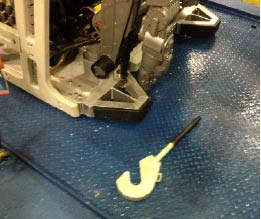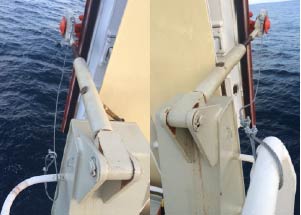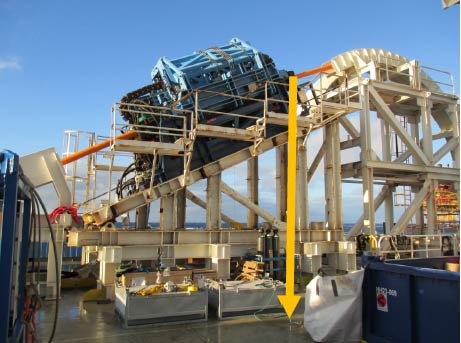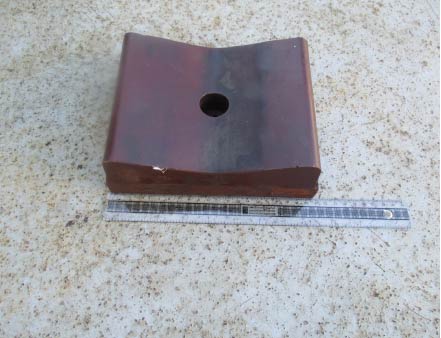Dropped object incidents
A member has highlighted a number of dropped object incidents in recent months, two of which were considered high potential and reportable to the local regulatory authorities. This safety flash serves as a reminder about the danger of dropped objects, highlighting that there can be no cause for complacency at any time.
High potential incident 1 – dropped ROV hooks
A survey support vessel was closing the ROV hangar doors following recovery of the ROV. This entailed the removal of two ‘hooks’ that were securing the ROV door in position. Numerous attempts were made to lift the first hook, but it would not move. The crew member then proceeded to unscrew the hook. Unfortunately, on reaching the end of the threaded section, the hook fell to the ROV hangar floor. The crew member then employed the same removal method for the second hook, with the same result. This time the hook fell into the sea.


Our member noted the following:
- A full report on this incident has been prepared;
- The area was made safe and a DROPS sweep conducted for further potential dropped objects (both ROV hangars). A similar dropped object survey was conducted through all areas of the vessel;
- Braided steel wire fastened to hooks were used as secondary hold backs – a permanent solution being assessed from an engineering perspective; . No personnel permitted in ROV hangar during opening/closing of doors;
- A full Root Cause Analysis incident Investigation had been carried out.
The following two incidents occurred within 24 hours of one another:
High potential incident 2 – tensioner pad fell 7m to deck
During ‘routine’ change out of pads on the tensioner a pad was dropped and fell approximately 7m on to the vessel deck. The pads were being changed out to allow for a different dimension of pipe to be fed through. The old/new pads were being passed via a ‘human chain’ from one person to another, from the tensioner to the deck via a series of work platforms. The operator had removed the securing bolt and a crewman, who was assisting, had difficulty removing the pad as it was tightly fitted. With some effort the pad came loose and the crewman fumbled and dropped the pad. The pad hit the tensioner frame and dropped down through the lay ramp to the vessel deck.
It should be noted that this activity was being conducted under a Permit to Work, with a risk assessment in place. The area was also barriered off so that no-one could enter the area below the tensioner. The vessel crew had taken every precaution to reduce the risk of injury to personnel to ALARP.


Incident 3 -Plastic ROV Launch and Recovery System (LARS)
During recovery of the starboard side ROV a plastic ladder ‘swing gate’ arm was observed to fall to the ROV hangar deck from the LARS. Personnel were working in the vicinity, as part of the ROV recovery operation, but were unharmed. The plastic arm weighed 0.75kg and fell 7m to the floor.

On investigation, it is thought that the swing gate arm was not properly installed and the vessel vibration caused the arm to work loose. An inspection of the port side LARS swing gate arm showed it was in good condition with no issues observed.
Our member noted the following:
- A full DROPS sweep was conducted for further potential dropped objects;
- Dropped object surveys should be carried out, with secondary hold-backs installed (where required) and regularly checked, for new and existing vessels and for new equipment;
- Appropriate control measures (e.g. Permits to Work, Risk Assessments and barriers) are important factors in reducing risks.
Dropped objects are one of the most common types of hazards in our industry. The consequences of an impact from a dropped object can include fatalities and/or serious injuries and/or serious damage. The risks from these hazards must be adequately managed and controlled, like any other risk. To achieve this, due consideration should always be given to the potential for dropped objects, to identifying how they may occur and how they can be prevented.
Members are encouraged to bring these incidents to the attention of their offshore crews, as a means to increasing awareness on potential dropped objects. Before starting any task, all personnel should consider the environment where they work and other activities going on in the vicinity.
Potential dropped objects should be risk assessed, giving consideration to its potential and probability of occurrence. Local work areas should be visually inspected for potential dropped objects, removing or securing them as appropriate. Personnel can be reminded that not only can anyone call an ALL STOP, but that they should call an ALL STOP if they see any act or condition they consider is, or may be, unsafe.
IMCA members have reported more than 10 incidents this year involving dropped objects or dropped object near misses. In last year’s (2013) IMCA contractor member safety statistics, 23% of reported LTIs were caused by persons being struck by moving or falling objects.
Members are reminded of IMCA promotional material as follows:
- Working at height (pocket card)
- Avoiding dropped objects (pocket card)
- Avoiding dropped objects (poster)
- Working at height (video)
Safety Event
Published: 25 November 2014
Download: IMCA SF 18/14
IMCA Safety Flashes
Submit a Report
IMCA Safety Flashes summarise key safety matters and incidents, allowing lessons to be more easily learnt for the benefit of all. The effectiveness of the IMCA Safety Flash system depends on Members sharing information and so avoiding repeat incidents. Please consider adding safetyreports@imca-int.com to your internal distribution list for safety alerts or manually submitting information on incidents you consider may be relevant. All information is anonymised or sanitised, as appropriate.
IMCA’s store terms and conditions (https://www.imca-int.com/legal-notices/terms/) apply to all downloads from IMCA’s website, including this document.
IMCA makes every effort to ensure the accuracy and reliability of the data contained in the documents it publishes, but IMCA shall not be liable for any guidance and/or recommendation and/or statement herein contained. The information contained in this document does not fulfil or replace any individual’s or Member's legal, regulatory or other duties or obligations in respect of their operations. Individuals and Members remain solely responsible for the safe, lawful and proper conduct of their operations.
